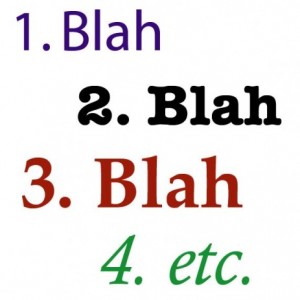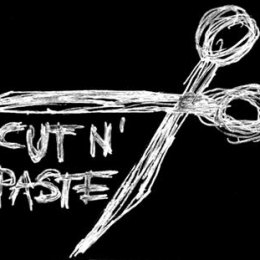A question I hear often is, “How do I know if I’m including enough information for the creative team?”
It’s the wrong question.
I’d prefer it re-phrased: “How do I know if I’m including the right information for the creative team?”
The creative brief is an exercise in reduction, so judicious editing and conciseness are the order of the day. The list below is probably not definitive. I’m sure I’ll think of something else. But follow these guidelines to keep your brief focused.
1. Business, marketing or insider jargon
There is no place for any of it on a creative brief.
Yet I see phrases like, “Boost quarterly sales” and “Retail stores need to move XX units per day to meet target goals” and “Margins are slipping so….” and “OEM silo yields are off by 12%” and….yadda yadda yadda. I’m sure you’ve read worse. 
It’s enough to make a creative cry. How does any of this relate to the task before the creative team? How does it provide any inspiration for creative ideas? They don’t.
Instead, these phrases, and so many others like them, indicate disengagement with writing an inspired creative brief. It’s laziness. Creative brief writers who collaborate with someone on the creative team would not make this mistake.
Remember who your audience is: The creative team. They know they have to increase sales. It’s your job to give them the relevant information to accomplish that goal.
2. Bullet points
Never. Never. Never. Bullet points are another sign of disengagement from writing an inspired creative brief. And laziness.
 Yet this is a sin repeated over and over. Especially in the box that describes the target audience. It’s usually a list of bullet points with silly acronyms (HHI is my favorite) that do nothing to inform or inspire the creative team.
Yet this is a sin repeated over and over. Especially in the box that describes the target audience. It’s usually a list of bullet points with silly acronyms (HHI is my favorite) that do nothing to inform or inspire the creative team.
Here is one of my favorite word pictures describing a cold sufferer for a creative brief for Vicks, a product made by Proctor and Gamble.
Who are we talking to?
Cold sufferers. You know how you feel when you’ve got a cold—that pathetic little inner-child of yours suddenly wakes up and, before you know it, you’re moaning & whining, you’ve gone all whiney & wimpy, all snivel, snot & slovenly; red raw puffy eyes, pale skin, lank hair—everything seems to be sagging! You feel like something from a Salvador Dali painting; you want to snuggle up in bed and dammit—you want your Mummy! But it’s not fair, is it, because no one else takes your suffering seriously—”Good God, pull yourself together, man, we’re not talking leprosy here! Don’t be such a baby, get on with it, stop moaning!”
Yes, your instincts tell you to be a child, but you’re not allowed to because you’ve “only” (only!) got a cold. And worse still—oh, the cruel irony!—even your attempts to retain your adulthood in the midst of your suffering betrays that sniveling little inner–child of yours: “oh don’t worry about me, I’ll be all right…”, “…no, no, please, I don’t want to sound like a martyr…”, “…well, I’m feeling a little better now, thank you…”
I’m sorry, but when you’ve got a cold you’re doomed to be a Child–Adult.
This is over-the-top fun and inspiring. And nary a bullet point in sight. Go to school on this approach. Show your creative team you brought your A game.
3. “See below”
I know it’s hard to believe, but I used to see this one. Often. Sometimes in the Single-Minded Proposition box of all places. Scary. Or in the Communication Objectives box. As if the brief writer did not understand the purpose of the box they were filling in. It was either a sign of complete laziness or simple incompetence. Or both.
Every box on a creative brief is there for a reason. It is not an easy thing to write an inspired brief, so give it the due diligence it deserves.
4. Anything cut and pasted from the previous creative brief
There might be exceptions, but I can’t think of any. Every project deserves fresh thinking, a fresh creative brief.
Put it another way: Would you accept from your creative team creative concepts that were cut and pasted from a previous campaign? No, I didn’t think so. Case closed. 
5. Anything cut and pasted from the client brief
This is almost worse than cutting and pasting from a previous agency-generated creative brief. The creative brief’s entire purpose is to “respond” to the client brief, to clarify the assignment and communicate to the client that the agency or creative department has understood its marching orders. (Yes, a creative brief has two audiences: the creatives, of course, but also the client, who should sign off on the brief.)
Were I the client and saw my own words on my agency’s creative brief, I’d be pissed. I’ve been on the client side, too. Fortunately, I never witnessed such laziness. Unfortunately, I saw it all too often in my role as a creative director.
6. A Single-Minded Proposition more than two typed lines
More laziness. The SMP should be short and to the point. It should read like a great headline on a billboard. It is the first ad as described by John Hegarty, which you’ve read here many times.
Be concise. Be sharp. Be witty if you can. And keep it short.
7. A third page
Somewhere in my book I wrote that I’d actually seen a well-written brief that was five pages in length. Not sure what I was thinking when I wrote that. I might have seen such a thing, but it’s a rarity.
The best briefs live up to their names. They are ideally one page, at most two pages. Again, remember that a brief is an act of strategic reduction. It is an exercise in lighting a fire beneath the creative team.
Do it in as few words as possible, but make those words heavy-weight champs: They float like a butterfly and sting like a bee.
8. The kitchen sink
This is an all-purpose “does not belong” catch-all. This is when you see the third, fourth and fifth page on a creative brief. It results when the brief writer is unsure and just decides to throw in everything to cover his behind.
The rationale? “More is better than less.” It’s the opposite of “inspired creative brief” thinking.
Can you think of other things that should never show up on a creative brief? Send me your ideas.

